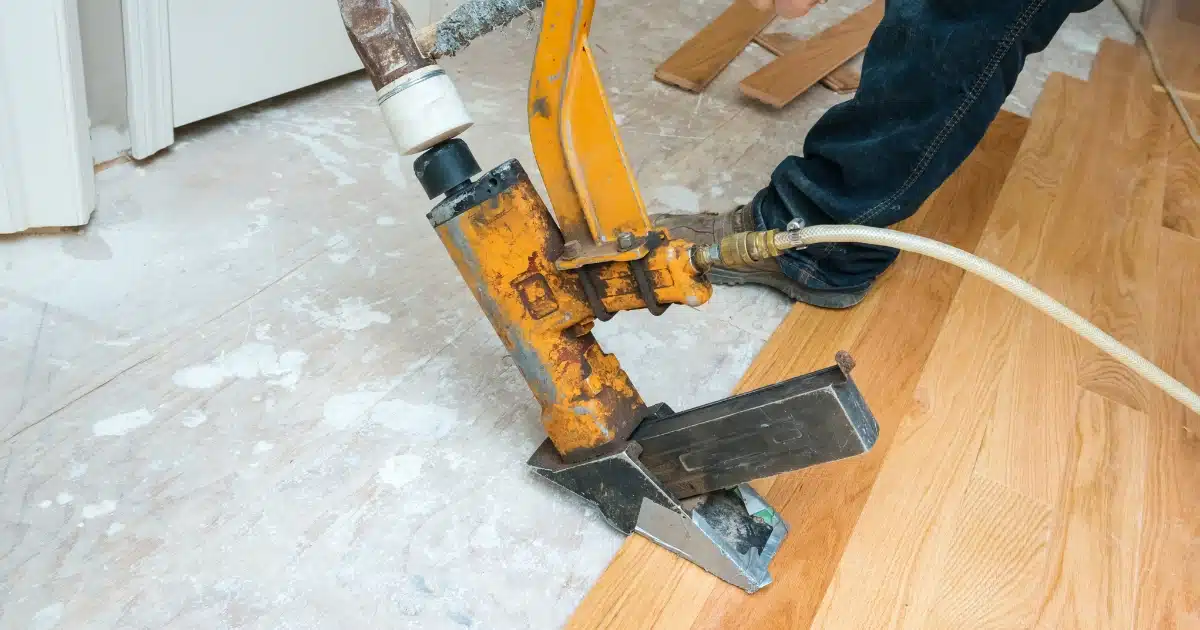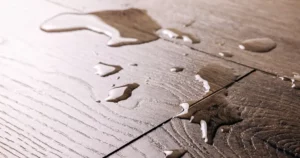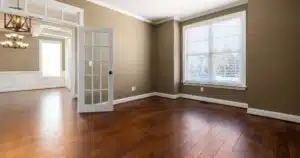Installing hardwood floors can be expensive, but there are smart ways to save without sacrificing quality. Whether you hire professionals or go the DIY route, you can achieve beautiful hardwood floors while sticking to your budget. Here are some quick tips to help you save:
- Choose budget-friendly hardwoods: Opt for oak or maple, which are durable and widely available.
- Consider engineered hardwood: It offers the look of solid wood at a lower price and is easier to install.
- Buy in bulk: Take advantage of seasonal sales for significant savings.
- DIY removal and preparation: If you’re handy, remove old flooring and prepare the subfloor yourself to cut labor costs.
- Stick to simple patterns: Choose a straight-lay installation to avoid extra charges.
- DIY installation: Save thousands in labor fees by installing it yourself if you have the skills.
- Avoid upsells: Avoid extras from flooring companies that can inflate your bill.
- Time your installation: Schedule during off-peak seasons and get multiple quotes for the best deal.
- Request free in-home measurements: This will help you order the right amount of flooring material, avoiding excess or shortages.
Let’s explore these money-saving tips to achieve your desired look without overspending!
Choose Budget-Friendly Hardwood Options
The type of hardwood flooring you choose plays a crucial role in your overall costs. Some wood species are more budget-friendly while still offering excellent durability and aesthetic appeal.
Here’s a detailed look at your options:
| Wood Type | Price Per Square Foot (Materials) | Durability | Aesthetic Appeal | Best For |
| Oak | $3-$7 | High | Classic grain patterns, versatile finishes | Living rooms, kitchens |
| Maple | $5 – $10 | Very High | Light color, smooth grain | High-traffic areas, modern spaces |
| Hickory | $6 – $11 | Extremely High | Distinctive grain, rustic look | Cabins, rustic homes |
| Walnut | $8 – $12 | High | Rich, dark tones, elegant appearance | Formal settings, dining rooms |
| Exotic Woods | $10 – $20 | Varies | Unique colors and patterns | High-end applications, luxury homes |
- Oak: A classic hardwood flooring type that balances affordability and durability.
- Versatile enough to fit various decor styles
- Price: Ranges from $3 to $7 per square foot.
- Durability: Highly durable, making it a top choice for families and high-traffic areas.
- Aesthetic Appeal: Oak’s classic grain patterns suit various decor styles, from traditional to contemporary.
- It is perfect for living rooms and kitchens where durability is crucial.
For quality oak options, explore Mohawk Tecwood or Shaw Hardwood.
- Maple: Another excellent pick, known for its hardness and resistance to wear.
- Price: Typically priced between $5 and $10 per square foot.
- Durability: Very hard and resistant to wear, making it great for busy households.
- Aesthetic Appeal: Features a light color and smooth grain, offering a clean and modern look.
- Ideal for high-traffic areas like hallways and family rooms.
- Hickory: Offers a unique rustic charm with its distinctive grain patterns.
- Price: Costs between $6 and $11 per square foot.
- Durability: Extremely durable, hickory is one of the hardest domestic woods available.
- Aesthetic Appeal: Its distinctive grain patterns provide a rustic charm that stands out.
- Best For: Perfect for cabins or rustic-themed homes.
Consider products from Mullican Hardwood for durable hickory options.
- Walnut: Provides a touch of elegance with its rich, dark tones.
- Price: Ranges from $8 to $12 per square foot.
- Durability: High durability with a luxurious feel.
- Aesthetic Appeal: Rich, dark tones add elegance and warmth to a space.
- Best suited for formal settings like dining rooms or offices.
For beautiful walnut flooring, consider Anderson tuftex, known for its sustainable sourcing.
- Exotic Woods while pricier, can add a stunning focal point to luxury homes.
- Price: Prices range from $10 to $20 per square foot.
- Durability: Varies by species but generally offers good durability.
- Aesthetic Appeal: Unique colors and patterns can be a stunning focal point.
- Ideal for high-end applications where aesthetics are paramount.
Look for reputable retailers that specialize in imported woods for the best selection.
Money-Saving Tip:
- Opt for oak or maple, maple for durability and availability.
- Avoid expensive exotic woods like Brazilian cherry and mahogany.
- Consider COREtec Calypso Oak and COREtec Cairo Oak as budget-friendly options.
Consider Engineered Hardwood Instead of Solid Hardwood
Engineered hardwood is a practical and cost-effective alternative to solid hardwood, offering the same aesthetic appeal while being easier to install and maintain
Summary Table!
| Flooring Type | Cost Per Square Foot | Durability | Installation Difficulty | Lifespan | Moisture Resistance | Ideal Locations |
| Solid Hardwood | $5 – $12 | High | Hard (Professional Recommended) | 30+ years | Moderate | Living rooms, bedrooms |
| Engineered Hardwood | $3 – $10 | Moderate | Easier (DIY Friendly) | 20 – 30 years | High | Kitchens, basements, high-traffic areas |
Many homeowners find themselves debating between these two options, but here’s why engineered hardwood might be your best choice:
- Cost-Effective:
- Typically costs $3 – $10 per square foot, compared to solid hardwood at $5 – $12. This can lead to significant savings.
- Durability:
- Lasts 20 – 30 years. While solid hardwood can last longer, engineered hardwood is less prone to warping due to humidity.
- Ease of Installation:
- Features click-lock systems, making it DIY-friendly. This means you can save on labor costs if you choose to install it yourself.
- Moisture Resistance:
- Great for high-moisture areas like kitchens and basements, where solid hardwood might struggle.
- Variety:
- Available in various styles, colors, and finishes to suit any decor.
Money-Saving Tip:
- Engineered hardwood reduces both material and labor costs.
- Ideal for DIY installation, saving on professional help.
Buy in Bulk and Look for Discounts
When planning your flooring project, buying materials in bulk can lead to substantial savings. Here’s how to maximize your budget:
- Bulk Purchasing:
- Buying in larger quantities often reduces the per-unit cost. If you need flooring for multiple rooms, consider ordering enough for the entire project at once.
- Wholesale Deals:
- Look for wholesalers that offer discounted prices on bulk purchases. These deals can significantly lower your overall costs.
- Clearance Sales:
- Keep an eye out for clearance sales, especially at the end of a season. You can find deep discounts on overstocked or discontinued items.
- Seasonal Sales:
- Many retailers run promotions during holidays or seasonal sales, providing an excellent opportunity to snag great deals.
- Local Flooring Warehouses:
- Check with nearby flooring warehouses for bulk pricing options. They often have competitive rates that can help you save money.
- Contractor Pricing:
- Even if you’re handling the installation yourself, don’t hesitate to ask for contractor pricing. Many suppliers offer discounts to DIYers who inquire.
Money-Saving Tip:
- Buy materials in bulk for substantial savings.
- Look for wholesale deals or clearance sales to maximize your budget.
- Time your shopping for the best deals.
- Look for discounts during holidays and special promotions.
- Take advantage of end-of-stock sales for deep discounts.
- Explore options at Rogers Family Flooring for competitive prices and great deals on flooring materials
Remove Old Flooring Yourself
Removing old flooring can be a hidden cost in your renovation project. Many flooring companies charge extra for this service, which can add $1 – $3 per square foot to your total expenses.
Here’s a money-saving tip to help you save on your flooring project
- DIY Removal:
- If you’re comfortable using basic tools, consider removing the old flooring on your own. It’s a straightforward task that can save significant labor fees.
- Cost Savings:
- By handling the removal yourself, you can keep those extra costs in your pocket, making your overall project more budget-friendly.
- Disposal Options:
- After removal, dispose of the old flooring responsibly. Check with local recycling centers that accept flooring materials to ensure eco-friendly disposal.
Handle Subfloor Preparation Yourself
Preparing the subfloor is a crucial step before installing hardwood flooring, and many contractors charge extra for this, increasing your overall costs. A clean, level, and dry subfloor is essential for a successful installation; improper preparation can lead to warping or uneven flooring.
Steps for DIY Subfloor Preparation
- Check for Uneven Areas:
- Inspect your subfloor for dips or bumps using a level. Sand down any uneven spots to create a smooth surface.
- Thorough Cleaning:
- Remove debris, dust, or old adhesive from the subfloor. A clean surface helps with adhesion and prevents complications during installation.
- Moisture Check:
- Use a moisture meter to check the dryness of your subfloor. Address any moisture issues to prevent mold or damage to your flooring.
Money-Saving Tip:
- Handle subfloor preparation yourself to save on contractor fees.
- Ensures a solid foundation for your hardwood flooring.
Choose a Simple Installation Pattern
The pattern you choose for hardwood flooring installation can affect labor costs. Different patterns require varying skill levels and time, impacting your overall budget.
Here’s an in-depth look at common flooring patterns, their difficulty levels, and associated costs:
| Installation Pattern | Difficulty Level | Additional Cost |
| Straight Lay | Easy | None |
| Diagonal | Medium | 10-15% More |
| Herringbone | Hard | 20-30% More |
| Parquet | Very Hard | 30-50% More |
1. Straight Lay
- Most straightforward flooring option.
- Planks or tiles installed parallel to the walls.
- Quick and efficient installation.
- Minimal cutting and basic skills required.
- No extra labor costs incurred.
- Ideal for a clean, classic look.
2. Diagonal Pattern
- Adds visual interest and elegance to a room.
- Involves cutting planks at an angle, increasing complexity.
- Requires precise measurements for a seamless look.
- Labor costs may rise by about 10-15% due to extra time and skill involved.
3. Herringbone
- Creates a distinctive zigzag effect.
- Popular for adding character to a space.
- More labor-intensive installation.
- Requires careful planning and precise cuts.
- Labor cost increase of 20-30%.
- Enhances the aesthetic appeal of flooring.
4. Parquet Flooring
- Features intricate geometric designs.
- Often combines different wood types or colors.
- Labor-intensive and demands high craftsmanship.
- Labor costs rise by 30-50% due to complexity.
- Final result can be stunning; consider these costs in your budget.
Money-Saving Tips:
- Stick to a Straight Lay Pattern
- Consider Diagonal for a Slight Upgrade
- Avoid Complex Patterns if Budget is Tight
Install the Floors Yourself (If You Have the Skills)
Hiring professionals for flooring installation can cost $3 to $8 per square foot for labor alone. If you have DIY skills, installing the flooring yourself can save you thousands. Here’s what to consider for a successful project.
Benefits of DIY Hardwood Flooring Installation
- Cost Savings: Eliminate labor costs and save significantly, allowing funds for better materials.
- Control: Manage your timeline and quality of work.
- Satisfaction: Enjoy the accomplishment of completing a home project yourself.
Considerations Before You Start
- Skill Level: Assess your comfort with tools and techniques. Some materials are easier to work with than others.
- Tools Required: Gather necessary tools like a tape measure, saw, and flooring nailer. Renting tools can save money.
- Preparation: Ensure a clean, dry, and level subfloor to avoid future issues.
- Follow Instructions: Adhere to manufacturer guidelines to maintain warranties and ensure longevity.
- Time Commitment: Be prepared for a significant time investment.
Installation Techniques
- Acclimation: Let hardwood or laminate acclimate to the room’s conditions for 48 hours.
- Layout Planning: Start from the center or a straight wall, maintaining consistent expansion gaps.
- Use a Level: Regularly check for level surfaces to prevent future issues.
- Finishing Touches: Complete the look with baseboards and transition strips.
Money-Saving Tips
- Assess Your Skills: Only proceed if confident in your abilities.
- Rent or borrow specialized tools instead of buying them.
- Choose DIY-Friendly Flooring: Opt for easier materials like engineered hardwood
- Plan for Extra Time: Allow for potential setbacks to avoid rushing.
- Watch installation tutorials and read manufacturer instructions before starting.
- Start with a small, low-traffic area before committing to a full DIY installation.
Avoid Unnecessary Extras
Many flooring companies upsell services that may not be necessary. By being aware of these upsells, you can save money without compromising quality. Here are key considerations:
Common Upsells to Avoid
- Moisture Barriers:
- Often recommended for basements, but skip it if your subfloor is dry and stable.
- Trim and Molding:
- Purchase trim and molding from a local hardware store instead of the flooring company to avoid markups.
- Professional Cleaning Services:
- Handle post-installation cleanup yourself to save on costs.
Money-Saving Tips
- Skip costly moisture barriers unless your subfloor truly requires one.
- Buy your own trim and molding from a hardware store instead of the flooring company.
- Handle post-installation cleanup yourself instead of paying for a professional cleaning service.
Time Your Installation for Off-Peak Seasons
Flooring contractors adjust their pricing based on demand, particularly during peak seasons in spring and summer. Understanding these trends can help you save money while ensuring quality service.
Why Prices Fluctuate with Seasons
- Increased Demand:
- Spring and summer are popular for renovations, leading to higher prices as contractors take on more jobs.
- Labor Availability:
- More laborers may be available, but prices increase due to the high demand for their services.
- Material Costs:
- Materials may also rise in price during peak seasons due to increased demand.
Money-Saving Tip:
- Schedule in Off-Peak Seasons: Aim for fall or winter to benefit from lower prices.
- Book Early: Secure your installation in advance for potential discounts.
- Negotiate Pricing: Discuss options with your contractor and ask about promotions.
- Consider Package Deals: Look for bundled services for additional savings.
- Stay Flexible: Be adaptable with your installation dates to take advantage of lower rates.
Shop Around and Get Multiple Quotes
Labor costs for flooring installation vary significantly between contractors. To get the best deal, obtain multiple quotes. This helps you compare prices and assess the quality of service offered by each contractor.
Why Labor Costs Vary
- Experience and Expertise: More experienced contractors charge higher rates; less experienced installers may offer lower prices but come with risks.
- Company Overheads: Varying operational costs affect pricing based on location and services offered.
- Project Complexity: Unique designs may require more skilled labor, influencing labor costs.
Strategies to Secure the Best Deal
- Request Multiple Quotes: Get at least three quotes from different installers to compare pricing and services.
- Inquire About Price Matching: Ask contractors about price matching policies or available discounts.
- Read Customer Reviews: Research reviews to avoid hiring unqualified installers who may lead to costly mistakes.
Money-Saving Tips
- Get at least three quotes to ensure competitive pricing.
- Negotiate with contractors for better rates or discounts.
- Check for seasonal promotions that might lower costs.
- Consider package deals that include installation and materials.
By obtaining multiple quotes and following these tips, you can secure a fair price for your flooring installation while ensuring quality workmanship. For a personalized quote, feel free to visit Rogers Family Flooring. We’re here to help!
Bonus Considerations for Money-Saving on Hardwood Floor Installation
- Maintenance Savings:
- Regular cleaning prevents damage and reduces costly repairs.
- Use area rugs in high-traffic areas to protect flooring and save on replacements.
- Home Value Impact:
- Quality hardwood enhances aesthetics and increases resale value.
- Sought-after species like oak or walnut can attract buyers and yield a higher selling price.
- Moisture Resistance:
- Consider engineered hardwood for moisture-prone areas.
- Better humidity resistance reduces the risk of warping and future repair costs.
- Free In-Home Measure:
- Schedule a free measure to select the right flooring without guesswork.
- Receive expert advice on installation and product selection to save money in the long run.
To further save on costs, consider scheduling a free in-home measure. This service helps you select the right flooring without guesswork, providing expert advice on installation and product selection tailored to your home’s specific conditions, ultimately saving you money in the long run.
For additional expert insights into hardwood flooring, visit the National Wood Flooring Association. This organization offers valuable resources, including installation guidelines and maintenance tips, helping you make informed decisions for your flooring projects.
Final Thoughts
Installing hardwood floors is a significant investment, but you can save money without compromising quality. Choose budget-friendly materials like oak or maple, and consider engineered hardwood options to reduce costs while achieving your desired look.
Taking on tasks like removing old flooring or preparing the subfloor yourself can lead to substantial savings. Be strategic with your purchases by buying in bulk, timing your installation during off-peak seasons, and obtaining multiple quotes to ensure you get the best value for your investment.
With these tips, you can navigate the flooring market effectively and create beautiful hardwood floors that enhance your home’s appeal while staying within budget. For personalized assistance and to request a quote, visit Rogers family flooring.





